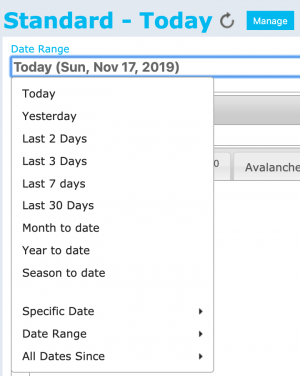Difference between revisions of "Specifying the date or date range of an InfoEx report"
Jump to navigation
Jump to search
m (→Related documents) |
|||
| Line 6: | Line 6: | ||
==Background== | ==Background== | ||
Users can specify a date or date range for the InfoEx report. Once the time period is specified, the application queries the InfoEx server and retrieves all of the information required for the current report template and the requested time period. | Users can specify a date or date range for the InfoEx report. Once the time period is specified, the application queries the InfoEx server and retrieves all of the information required for the current report template and the requested time period. | ||
| − | |||
| − | |||
| − | |||
| − | |||
| − | |||
| − | |||
| − | |||
| − | |||
| − | |||
| − | |||
| − | |||
| − | |||
| − | |||
==Step-by-step description== | ==Step-by-step description== | ||
| Line 28: | Line 15: | ||
|- | |- | ||
|class="StepNum" | 2. | |class="StepNum" | 2. | ||
| − | |[[File:ReportTabularViewDateSelection.png|300px|thumb|right|Fig. 2: Date and date range dropdown menu]] Select the appropriate date or date range for your InfoEx report (Fig. 2). | + | |[[File:ReportTabularViewDateSelection.png|300px|thumb|right|Fig. 2: Date and date range dropdown menu]] Select the appropriate date or date range for your InfoEx report (Fig. 2). The available options include: |
| + | * Relative dates or date ranges | ||
| + | ** Today | ||
| + | ** Yesterday | ||
| + | ** Last 7 days | ||
| + | ** Last 30 days | ||
| + | ** Month to date | ||
| + | ** Year to date | ||
| + | ** Season to date (Season starts on Oct. 1) | ||
| + | {{Note|Please note that data requests with 'Year to date' or 'Season to date' can produce extremely large reports that require a long time to download. Only use these options when you have a high-speed Internet connection.|NoteWithImage}} | ||
| + | * Absolute dates or date ranges | ||
| + | ** Specific date | ||
| + | ** Date range | ||
|- | |- | ||
|class="StepNum" | 3. | |class="StepNum" | 3. | ||
Revision as of 16:55, 31 December 2013
| REQUIREMENTS | |
| Permission | All user levels |
| Connectivity | Online only |
This document describes how to specify the date or date range of an InfoEx report.
Background
Users can specify a date or date range for the InfoEx report. Once the time period is specified, the application queries the InfoEx server and retrieves all of the information required for the current report template and the requested time period.
Step-by-step description
| 1. | Click into the text box under the 'Date Range' label of the report view (Fig. 1). | ||
| 2. | Select the appropriate date or date range for your InfoEx report (Fig. 2). The available options include:
| ||
| 3. | Wait while the application retrieves the data for the new date or date range from the server and displays it in the current view. |
Related documents
Functionality tested by
- Oct. 28: Pascal Haegeli / QA Server / Test Version 0.32.00

